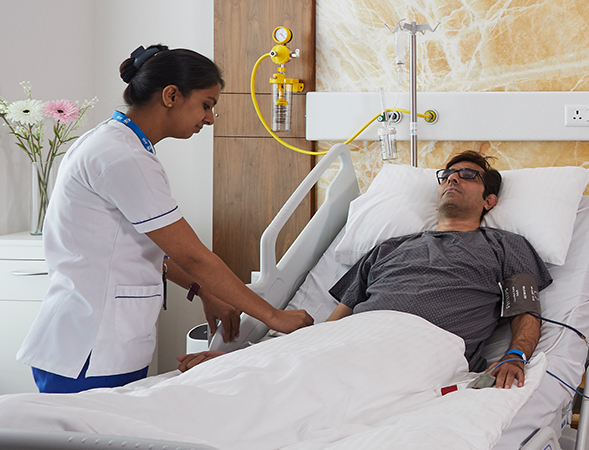Laparoscopic bariatric surgery refers to a surgical procedure, which uses an instrument called laparoscope to reduce weight in severely obese people of body mass index (BMI) >40kg/m2. This surgery can also be performed in obese people whose BMI is between 35-40 kg/m2 and having severe health conditions, such as type 2 diabetes, high blood pressure, or heart diseases.
-
Laparoscopy +
Laparoscopy is also known as keyhole surgery, as it requires only small incisions unlike traditional or open surgery. Laparoscopy is a minimally invasive surgical procedure that uses a laparoscope, which is a long, thin and flexible tube mounted with a high-intensity light and a high-resolution camera at its tip. Laparoscopic procedures can be performed efficiently by expanding the abdomen with carbon-dioxide (CO2) gas. The gas is removed at the end of the surgery.
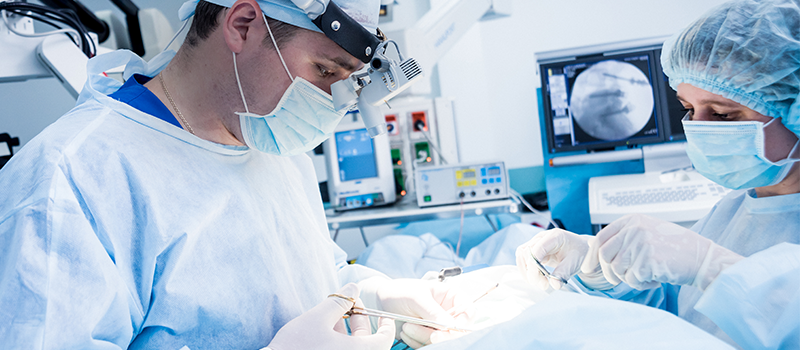
Laparoscopy is primarily used to examine the organs inside the abdomen, which helps to diagnose a variety of health conditions. It is also used to surgically remove the abnormal organ or a tissue sample for further testing (biopsy).
-
Pre-operative procedure +
Before surgery, the doctor performs physical examination of the patient to determine the patient’s BMI and also obtains the complete medical history of the patient. Some of the pre-operative tests for bariatric surgery include:

- Blood tests: To determine the presence of any infection.
- Chest X-rays: To identify any abnormalities of the heart, lungs, airway, blood vessels, and lymph nodes.
- Gastro-intestinal tests: To evaluate the process of food pathway and its digestion.
- Electrocardiogram (EKG): To detect any abnormalities in the electrical activity of the heart.
Diet: High-protein and low-calorie diet should be taken by the patient before surgery, which helps to reduce the amount of fat around the liver and spleen and promote the chance of a successful surgery. Blood sugar control in diabetic patients undergoing bariatric surgery is important and should be monitored.
Smoking cessation: Smoking should be stopped at least 6 weeks prior surgery to prevent the risks during surgery and complications, such as blood clots, anesthetic risks, and infections after surgery.
Medications: Over-the-counter medications, steroids, and birth control pills should either be stopped completely, or dose should be reduced at least one or two weeks before surgery, as advised by the physician.
-
During procedure +
Laparoscopic bariatric surgery is performed under general anesthesia. The surgeon decides the type of surgery to be done that is suitable to the patient.
Types of laparoscopic bariatric surgeries:
There are different types of laparoscopic bariatric surgeries. They are:
1. Laparoscopic sleeve gastrectomy
It is also called as ‘gastric sleeve’ or ‘vertical sleeve gastrectomy’. Initially, the surgeon makes five to six small incisions of about 1/4 to 1/2 inch on the abdomen. Then the laparoscope is inserted into the abdomen through the cannulas (narrow tube-like instruments) that are placed in the incisions of the abdomen. The surgeon can view the picture of the internal organs and stomach that is projected on a TV.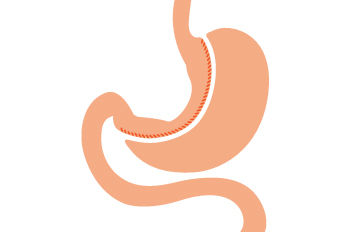
In this procedure, the surgeon removes almost 80% of the stomach, leaving only a small part of the stomach (sleeve) that resembles a banana. This newly created pouch can hold only small amounts of food and hence the person eats less and feels full soon. This procedure affects gut hormones and gut bacteria, which leads to reduced hunger and improved satiety (feeling of fullness) resulting in the weight loss.
This surgery is irreversible as most of the stomach is removed permanently. Gut hormones also have an impact on the blood sugar control, so this procedure is effective in improvement or remission of type 2 diabetes independent of the weight loss.2. Laparoscopic gastric bypass
It is also called as Roux-en-Y gastric bypass and is considered as the gold standard of weight loss surgery.
In this procedure, the surgeon makes small incisions on the abdomen to pass the laparoscope through incisions into the abdomen. Using the laparoscope, the upper part of the stomach is cut from the lower part of the stomach to create a small pouch of about a walnut size. The lower part of the small intestine is also separated from the upper part of the small intestine and is connected to the newly created upper stomach pouch. Then the bypassed section (left out portion of the stomach and upper part of the small intestine) is connected farther down to the lower portion of the small intestine. This enables the stomach acids and digestive juices from the lower part of stomach and first portion of small intestine to flow into the lower portion of the small intestine.
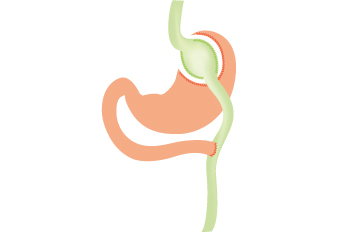
As the newly created stomach pouch is small, the person feels full after eating only small amounts of food. This procedure also affects gut hormones and gut bacteria that reduces hunger and improves satiety (feeling of fullness). The limited portion of the small intestine enables absorption of fewer calories and nutrients. This procedure is not reversible, as most of the stomach and small intestine are permanently removed. Apart from weight loss, laparoscopic gastric bypass also helps in improving obesity induced type 2 diabetes.3. Laparoscopic mini gastric bypass
Mini-gastric bypass is also called as ‘omega loop gastric bypass’ or ‘single-anastomosis bypass’. This procedure is also similar to Roux-en-Y gastric bypass. In laparoscopic mini-gastric bypass, initially, the surgeon makes small incisions on the abdomen and laparoscopically cuts the stomach to create a small pouch, just like gastric sleeve. This pouch is connected directly to the small intestine two meters away from its origin. The digestive juices flow from the bypassed section of the stomach and upper part of the small intestine into the lower part of the small intestine. As with the traditional gastric bypass, mini-gastric bypass also reduces appetite, improves satiety and absorbs only a fewer calories and nutrients resulting in the weight loss.
The main difference between the Roux-en-Y gastric bypass and mini-gastric bypass is that there is only one anastomosis (join between stomach and intestine) in mini-gastric bypass, whereas in the standard Roux-en-Y bypass there are two anastomoses - an upper and lower.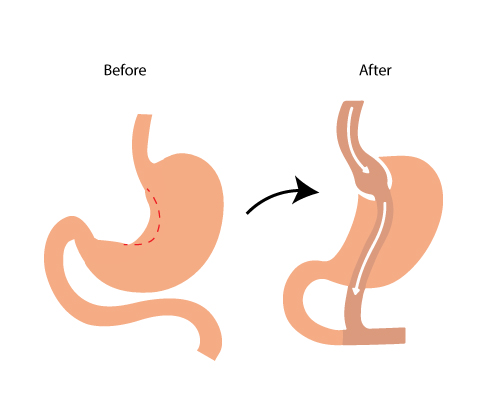
The advantages of mini-gastric bypass over Roux-en-Y gastric bypass are:- It is a quicker procedure.
- Less risk of infections and a faster recovery due to only one anastomosis.
- Weight loss outcomes are comparatively better than the Roux-en-Y gastric bypass.
-
Advantages of laparoscopic bariatric surgery +
Laparoscopic bariatric surgery has many advantages over traditional bariatric surgery, such as:
- Reduced post-operative pain
- Smaller incisions on the abdomen
- Reduced risk of infections
- Shorter hospital stay
- Faster recovery
-
Post-operative procedure +
After bariatric surgery, the patient is shifted to the recovery room, where medical staff monitors the patient for any complications. If the patient has any complications, it should be treated immediately before it gets worse. The typical hospital stay for bariatric surgery may last from three to five days. After one to two days of the surgery, X-rays will be taken to see if there is any leakage through the stapling of the stomach. If there is no leakage, then one ounce of fluids will be given every hour to the patient and slowly the volume of fluids will be increased. Later, the patients will be moved from liquid diet to a soft diet, such as cottage cheese, yogurt, or soup, and then to solid foods over several weeks. During discharge, the doctor will recommend specific diet plan and lifestyle modifications to the patient to promote the effects of bariatric surgery.
References
https://asmbs.org/patients/bariatric-surgery-procedures
https://www.mayoclinic.org/tests-procedures/bariatric-surgery/about/pac-20394258
https://www.sages.org/wiki/laparoscopic-weight-loss-surgery/
https://www.ncbi.nlm.nih.gov/pmc/articles/PMC5793145/
https://www.healthierweight.co.uk/gastric-bypass/mini-bypass/
- 1


